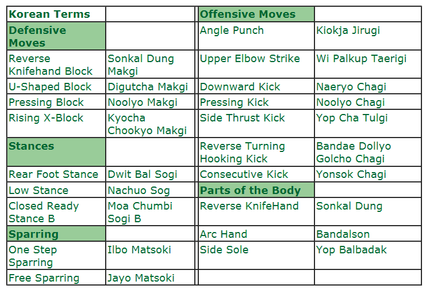Primary Taekwon-Do
Blue Belt - 4th Kup
Practical
Combinations in Line Work – Taken from patterns
Combinations of traditional kicks
3 Step Sparring – all
One step sparring traditional intermediate
Free Sparring
Self-defense, release moves, grasps and holds
Power test, techniques determined by examiner on the day
Sajo Jirugi 1, Sajo Jirugi 2, Sajo Makgi, Chon-Ji, Dan-Gun, Do-San, Won-Hyo, Yul-Gok & Joong-Gun

Theory
1.How many moves in Joong-Gun? – 32
2.Meaning of Joong-Gun? – Joong-Gun is named after the patriot Ahn Joong-Gun who assassinated Hiro-Bumi Ito, the first Japanese governor general of Korea , known as the man who played the leading role in the Korea-Japan merger. The 32 movements in this pattern represent Mr. Ahn’s age when he was executed in Lui-Shung prison in 1910.
3.What is the Korean for U-shape block and its purpose? – Digutcha Makgi – To block a pole or staff with the Arc hand of both hands
4.What other name is given to U-shape block. Both English & Korean? – Pole block – montong makgi
5.What is the Korean for Twin upset punch? – Sang Dwijibo Jirugi
6.What is the Korean for Rear foot stance & explain it? – Dwitbal Sogi
7.What is the Korean for Low stance & explain it? – Nachuo Sogi
8.What is the release move in Joong-Gun & explain it? – Japkgi (grasp), Japyasol tay (release)
9.Name 7 different blocks. Both in Korean & English? – Najunde Bakat Palmok makgi, Kaunde An palmok makgi, Najunde Sonkal makgi, Chookyo makgi, Sang Palmok makgi, Sonkal Daebi makgi, Hechyo makgi, Dollymio makgi, Golcho makgi, Sang Sonkal makgi, Doo Palmok makgi, Digutcha makgi, Noolyo makgi, Sonkal Dung makgi, and Kyocha Chookyo Makgi
10.Name 6 different kicks. Both in Korean & English? – Apcha busigi (front snap kick), Yop chajirugi (side piercing kick), Dollyo chagi (turning kick), Dwit chajirugi (back piercing kick), Bandae Dollyo chagi (reverse turning kick), Naeryo chagi (downward or axe kick), Noollo chagi (pressing kick), Yonsok chagi (consecutive kick)
11.Name 7 different stances. Both in Korean & English? – Gunnon (Walking), Annun (Sitting), Niunja(L stance), Narani (Parrallel), Charyot (Attention), Gojong (fixed), Moa (closed), Goburyo (bending), Kyocha ( “X” ), Nachuo (Low), Dwitbal (rear foot) Sogi (Stance).
12.Name 7 different hand parts. Both in Korean & English? – Fore fist (Ap Joomuk), Back fist (Dung Joomuk), Side fist (Yop Joomuk), Knifehand (Sonkal), Reverse Knifehand (Sonkal Dung), Finger tips (Sonkut), Arc Hand (Bandal Son), Elbow (Palkup), Palm (Sonbadak), Open fist/palm heel (Pyun Joomuk)
13.Name 5 different foot parts. Both in Korean & English? – Ball of the foot (Apkumchi), Foot sword (Balkal), Instep (Baldung), Back Heel (Dwichook), Toes (Balkut), Back sole (Dwitkumchi), Reverse Foot sword (Balkal Dung).
14.Name 6 different hand attacks from pattern Joong-Gun. Both in Korean & English? – Upward elbow strike – Wi Palkup Taerigi, Angle punch – Giokja Jirugi, Twin upset punch – Sang Dwijibo Jirugi, Twin Vertical punch – Sang Sewo Jirugi, Fore fist punch – Ap joomuk Jirugi, Backfist Strike – Dung Joomuk Taerigi
15.What is the ready position in Joong-Gun. Both in Korean & English? – Closed ready stance “B” – Moa jumbi sogi “B” (Hands 15cm from the Navel)
16.Why do we perform 1-step sparring? – To practice and learn distance, timing and correct target areas
17.Why do we perform patterns? – To practice both offensive & defensive techniques against imaginary opponent, or opponents. To build strength, speed, balance and timing with your body.
18.Why do we learn the meanings of patterns? – To gain inspiration and remember the history of those who came before us.
19.What is Pressing Block in Korean? – Noolyo Makgi
20.What is the Korean for “X” rising block? – Kyocha Chookyo Makgi
21.What does the colour red signify? – Red signifies danger, cautioning the student to exercise control, whilst warning the opponent to stay away.
22.What is the Korean for Angle punch? – Giokja Jirugi
23.One question from previous Gradings! – Remember and know your previous Theory